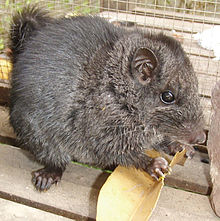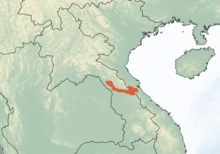| Laotian rock rat Temporal range: Late Miocene-Recent | |
|---|---|

| |
| Young male | |
| Conservation status | |
 Least Concern (IUCN 3.1) | |
| Scientific classification | |
| Domain: | Eukaryota |
| Kingdom: | Animalia |
| Phylum: | Chordata |
| Class: | Mammalia |
| Order: | Rodentia |
| Family: | Diatomyidae |
| Genus: | Laonastes Jenkins, Kilpatrick, Robinson & Timmins, 2005 |
| Species: | L. aenigmamus |
| Binomial name | |
| Laonastes aenigmamus Jenkins, Kilpatrick, Robinson & Timmins, 2005 | |

| |
The Laotian rock rat or kha-nyou (Laonastes aenigmamus, Lao: ຂະຍຸ), sometimes called the "rat-squirrel", is a species of rodent found in the Khammouan region of Laos. The species was first described in a 2005 article by Paulina Jenkins and coauthors, who considered the animal to be so distinct from all living rodents, they placed it in a new family, Laonastidae. It is in the monotypic genus Laonastes.

In 2006, the classification of the Laotian rock rat was disputed by Mary Dawson and coauthors. They suggested the rat belongs to the ancient fossil family Diatomyidae, which was thought to have been extinct for 11 million years, since the late Miocene. It would thereby represent a Lazarus species. The animals resemble large, dark rats with hairy, thick tails like those of a squirrel. Their skulls are very distinctive and have features that separate them from all other living mammals.
Classification
Upon their initial discovery, Jenkins and coauthors (2005) considered the Laotian rock rat to represent a completely new family. The discovery of a new species of an extant mammal genus, or a new genus, happens periodically, such as with the leaf muntjac or the saola. The discovery of a completely new family is, by comparison, much more unusual. The most recent comparable incident before this discovery by Western science was the discovery of the bumblebee bat (Craseonycteris thonglongyai; family Craseonycteridae) in 1974. The only other examples from the 20th century are species that are only considered distinct families by a few authorities. These discoveries are: the Chinese river dolphin (Lipotes vexillifer; family Lipotidae) in 1918, the Zagros mouse-like hamster (Calomyscus bailwardi; family Calomyscidae) in 1905, and Goeldi's marmoset (Callimico goeldii; family Callimiconidae) in 1904. Representatives from all the remaining rodent families with living representatives (approximately 30) were discovered before 1900.
Jenkins et al. did not compare the specimens to known rodent fossils. After such a comparison, Dawson et al. believed the Laotian rock rat belongs to a previously described family, which had only been known from fossils, the Diatomyidae, so not a new family at all, but simply one that had been believed extinct. The Diatomyidae are known from a series of fossils from the early Oligocene (~32.5 mya) until the Miocene (~11 mya). The discovery of the Laotian rock rat means an 11 million-year gap exists in the fossil record where no diatomyids have been found. Dawson et al. described the Diatomyidae as a Lazarus taxon due to this gap. The only other mammal Lazarus taxon with a comparable time gap between it and its most recently known fossil relative is the monito del monte, which is part of a marsupial family (Microbiotheriidae) also most recently known from Miocene deposits. Mary Dawson described Laonastes as the "coelacanth of rodents".
The analysis of mtDNA 12S rRNA and cytochrome b sequence by Jenkins et al. allied Laonastes with African hystricognath rodents, namely the blesmols and the dassie rat. Support for such a placement was fair, but the exact position could not be resolved. Huchon et al. conducted a large-scale molecular phylogeny of rodents, including representatives of all major rodent taxonomic groups, based on 5.5 kb of sequence data from four nuclear and two mitochondrial genes, and a short, interspersed element, insertion analysis including 11 informative loci. Their molecular data place Laonastes robustly as a sister clade of Ctenodactylidae, and support an ancient divergence during the Lutetian (Early/Middle Eocene, ~44 mya). The earlier molecular study was in error due to long branch attraction and inadequate sampling.
Etymology
The genus name for this animal, Laonastes, means "inhabitant of stone" (from Greek λαας = laas = stone, gen: λαος = laos = of stone and Greek ναστης = nastes = inhabitant). This is in reference to its presence around limestone rocks and also to the country where it was recently discovered. The specific epithet aenigmamus means "enigma mouse" (from Greek αινιγμα = ænigma and μυς = mus, "mouse") referring to its unknown position among the rodents (Jenkins et al., 2004).
Discovery
The first specimens were found for sale as meat at a market in Thakhek, Khammouan, in 1996. Remains of three additional animals were obtained in 1998 from villagers and in an owl pellet. Return trips to Laos by the Wildlife Conservation Society researchers uncovered several other specimens. These new discoveries have prompted the suggestion that the animals may not be as rare as once thought. On June 13, 2006, David Redfield, a professor emeritus of Florida State University, and Thai wildlife biologist Uthai Treesucon announced they had captured, photographed, and videotaped a live specimen of the species in the village of Doy in Laos.
Description
The animals look generally like rats, with thick, furred tails similar to a squirrel's, but limp. The head is large, with round ears and a somewhat bulbous bridge of the nose, and very long whiskers. Their fur is dark slate grey, with a blackish tail. The belly is lighter, with a small, whitish area in the center. Their eyes are beady and black. They are about 26 cm (10 in) long with a 14 cm (5.5 in) tail and weigh about 400 g (14 oz). Jenkins et al. (2004) described the jaw as hystricognathous, but Dawson et al. argued it is sciurognathous. The infraorbital foramen is enlarged, consistent with a hystricomorphous zygomasseteric system. The pterygoid fossae do not connect to the orbit, setting them apart from the hystricognathous rodents.
Distribution
The Laotian Rock rat is found in limestone karsts of Khammouan Province and southern Bolikhamxai Province, Laos, and also in a small area of Minh Hóa District, western Quảng Bình Province, Vietnam. In Vietnam, it is found in the 5 communes (xã) of Thượng Hoá, Hóa Sơn, Trung Hoá, Hóa Hợp, and Dân Hoá, and in Phong Nha – Kẻ Bàng National Park, near the villages of the Vietic-speaking Ruc, Sach, and Chut ethnic groups. It is also found directly across the border in Hin Namno National Biodiversity Conservation Area, Laos. In Laos, it is most common in the Phou Hin Poun National Biodiversity Conservation Area. Nguyen et al. suggested that the Quảng Bình and Phou Hin Poun populations may be distinct and genetically isolated from each other.
Nicolas et al. found 8 major geographical clades and 8 to 16 evolutionary significant units among Laotian rock rat populations in Laos, and suggested that Laonastes may in fact consist of various undescribed cryptic species.
Natural history
Laotian rock rats are found in regions of karst limestone. They appear to be found only among limestone boulders on hillsides. Villagers in the area are familiar with the animal, calling it kha-nyou, and trapping it for food. The animals are presumed to be nocturnal.
These rock rats appear to be predominantly herbivores, eating leaves, grass, and seeds. They may eat insects, as well, but probably not in high abundance. Females may give birth to a single young.
Laotian rock rats appear to be quite docile and slow-moving over open ground. They walk with feet splayed outward in a gait described as duck-like. Although not ideal for mobility on open surfaces, this appears to be efficient when scrambling up and across large rocks. The sideways angle allows for greater surface area for their feet to find purchase on tilted or parallel surfaces.
See also
References
- Duckworth, J.W. (2016). "Laonastes aenigmamus". IUCN Red List of Threatened Species. 2016: e.T136474A22199035. doi:10.2305/IUCN.UK.2016-2.RLTS.T136474A22199035.en. Retrieved 11 November 2021.
- Owen, James (May 16, 2005). "New Rodent Discovered at Asian Food Market". National Geographic News. Archived from the original on May 19, 2005. Retrieved Sep 19, 2010.
...odd-looking mammal, known locally as the kha-nyou....
- Srikameswaran, Anita (June 15, 2006). "Retired professor tracks down rodent thought to be extinct". Pittsburgh Post-Gazette. Retrieved Sep 19, 2010.
Dr. Dawson and her colleagues... determined that the rock rats belonged to a family called Diatomyidae, whose members were thought to have died off more than 11 million years ago.
- ^ Jenkins, Paulina D.; Kilpatrick, C. William; Robinson, Mark F.; Timmins, Robert J. (2005). "Morphological and molecular investigations of a new family, genus and species of rodent (Mammalia: Rodentia: Hystricognatha) from Lao PDR". Systematics and Biodiversity. 2 (4): 419–454. doi:10.1017/S1477200004001549. S2CID 86411689.
"Corrigendum: Volume 2(4): 419–454". Systematics and Biodiversity. 3 (3): 343. 2005. doi:10.1017/S1477200005001775. - ^ Dawson, M.R.; Marivaux, L.; Li, C.-k.; Beard, K.C.; Métais, G. (2006). "Laonastes and the "Lazarus effect" in Recent mammals". Science. 311 (5766): 1456–1458. Bibcode:2006Sci...311.1456D. doi:10.1126/science.1124187. PMID 16527978. S2CID 25506765.
- Carey, Bjorn (2006-03-09) Back from the dead: Living fossil identified. MSNBC
- Huchon, Dorothée; Chevret, Pascale; Jordan, Ursula; Kilpatrick, C. William; Ranwez, Vincent; Jenkins, Paulina D.; Brosius, Jürgen; Schmitz, Jürgen (2007). "Multiple molecular evidences for a living mammalian fossil". Proceedings of the National Academy of Sciences. 104 (18): 7495–7499. Bibcode:2007PNAS..104.7495H. doi:10.1073/pnas.0701289104. PMC 1863447. PMID 17452635.
- ^ "New pictures of 'living fossil'". BBC. 2006-04-06. Retrieved 2006-05-05.
- ^ ""Living Fossil" captured live on video". Florida State University. 2006-06-13. Archived from the original on 2017-09-08. Retrieved 2006-06-13.
- Palacios, E.; Wallace, R.B.; Mollinedo, J.M.; Heymann, E.W.; Shanee, S.; Calouro, A.M.; del Valle, E.; Mittermeier, R.A. (2021). "Callimico goeldii". IUCN Red List of Threatened Species. 2021: e.T3564A191700340. doi:10.2305/IUCN.UK.2021-1.RLTS.T3564A191700340.en. Retrieved 11 November 2021.
- ^ Nguyen, D. X., Nguyen, N. X., Nguyen, D. D., Dinh, T. H., Le, D. T., & Dinh, D. H. (2014). "Distribution and habitat of the Laotian Rock Rat Laonastes aenigmamus Jenkins, Kilpatrick, Robinson & Timmins, 2005 (Rodentia: Diatomyidae) in Vietnam". Biodiversity Data Journal. 2 (2): e4188. doi:10.3897/BDJ.2.e4188. PMC 4290499. PMID 25589873.
{{cite journal}}: CS1 maint: multiple names: authors list (link) - Nicolas V, Herbreteau V, Couloux A, Keovichit K, Douangboupha B, Hugot JP (2012). "A Remarkable Case of Micro-Endemism in Laonastes aenigmamus (Diatomyidae, Rodentia) Revealed by Nuclear and Mitochondrial DNA Sequence Data". PLOS ONE. 7 (11): e48145. Bibcode:2012PLoSO...748145N. doi:10.1371/journal.pone.0048145. PMC 3498270. PMID 23155377.
Further reading
- Wilson, D. E. & Reeder, D. M. (1993): Mammal Species of the World: A Taxonomic and Geographic Reference. Washington D.C., Smithsonian Institution Press.
- Herbreteau, V., V. Nicolas, R. Cornette, and J. P. Hugot. 2006. Une récente découverte au Laos: le Kha-nyou rongeur énigmatique. Le courrier de la Nature 213:28–33.
- Keovichit K, Nicolas V., Hugot J-P., 2011. Laonastes aenigmamus, an enigmatic rodent recently discovered in Laos. Bull. Acad. Vet., France 164, 135–140.
- Rivière-Dobigny T, Herbreteau V, Keovichit K, Douangboupha B, Morand S, Michaux J and Hugot JP. 2011. Highly divergent lineages within the recently described rodent species Laonastes aenigmamus. Implications for its conservation. Journal of Mammalogy 92 (3): 620–628.
- Herrel A, A-C Fabre, JP Hugot, K Keovichit, D Adriaens, L Brabant, L Hoorebeke and R Cornette, 2012. Ontogeny of the cranial system in Laonastes aenigmamus. J. Anat. 221:128–137 doi:10.1111/j.1469-7580.2012.01519.x
- "Oddball Rodent" Found (in Plain View) Is Called New to Science
- Carnegie Museum Press Release: "New family of mammal really living fossil" with images
- Environment News Service: "Rodent Discovered in Laos Defines New Family of Mammals" contains photos
- Retired Professor Captures A 'Living Fossil' – Laotian Rock Rat Once Believed To Have Gone Extinct Florida State University (ScienceDaily) June 14, 2006
External links
 Media related to Laonastes aenigmamus at Wikimedia Commons
Media related to Laonastes aenigmamus at Wikimedia Commons Data related to Laonastes aenigmamus at Wikispecies
Data related to Laonastes aenigmamus at Wikispecies- Tel Aviv University gene study supports "living fossil" hypothesis
| Taxon identifiers | |
|---|---|
| Laonastes aenigmamus | |














